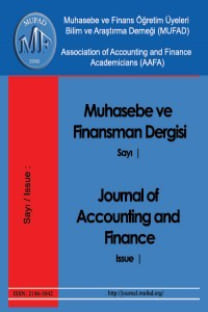How do business strategies predict firm performance? aninvestigation on borsa Istanbul 100 index
Bu çalışmada amaçlanan Miles ve Snowun strateji tipolojisinin Türkiyede birsınamasını gerçekleştirmek ve farklı stratejiler uygulayan firmaların ROA oranlarına görefirma performanları açısından nasıl farklılaştıklarını araştırmaktır. Çalışma Borsa İstanbul100 endeksinde listelenen 190 firma üzerinde gerçekleştirilmiştir. Firmalar kümeleme analiziyardımıyla 3 strateji tipolojisi altında gruplandırılmıştır. Bağımsız deği şkenler olarak seçilen Firma stratejisi , firma büyüklüğü ve sektör ün firma performansı (ROA) üzerindekietkisi ANOVA ve Lojistik regresyon yöntemleri ile analiz edilmiştir. Sonuçlar firmaperformansının (ROA) en iyi açıklayıcısının firma stratejisi ve firma büyüklüğünün etkileşimi olduğuna dikkat çekmektedir.
İşletme performansının açıklanmasında işletme stratejilerinin etkisi: İstanbulborsası 100 endeksinde bir araştırma
In this study it is aimed to verify Miles and Snow s strategy typology in Turkey andinvestigate how firms that conduct different business strategies, differ in firm performanceconsidering ROA ratio. Research conducted with 190 firms listed in Borsa Istanbul 100Index. Firms classified under 3 strategy typology with cluster analysis. The impact ofindependent variables ; firm strategy , industry and firm sizeon firm performance(ROA) were analysed by ANOVA and logistic regression. Results indicated that the bestpredictor of performance (ROA) is the interaction efffect of firm size and firm strategy.Anahtar Kelimeler: Business Strategies, Miles and Snow s Strategy Typology, ROA,Logistic Regression.
___
- Ansoff, I.(1965), Corporate strategy. New York: McGraw Hill.
- Barney J.B. (1991), The resource-based view of strategy: Origins, implications, and prospects, Journal of Management, Vol.17, pp. 97-211.
- Bentley, K.A- Omer, T.C.- Sharp, N.Y., (2013). Business Strategy, Financial Reporting Irregularities, and Audit Effort. Contemporary Accounting Research, Vol. 30, No. 2, pp. 780-817.
- Conant JS- Mokwa MP- Varadarajan PR.(1990), Strategic Types, Distinctive Marketing Competencies and Organizational Performance: A Multiple Measures- Based Study, Strategic Management Journal, Vol. 11, No. 5, pp. 365-383.
- Desarbo,W.S.- Benedetto, C. A.- Song, M.- Sinha, I. (2005). Revisiting The Miles And Snow Strategic Framework: Uncovering Interrelationships Between Strategic Types, Capabilities, Environmental Uncertainty, And Firm Performance. Strategic Management Journal, Vol. 26, pp. 47-74.
- Fiss, P.C (2011). Building Better Causal Theories: A Fuzzy Set Approach To Typologies in Organization Research, Academy of Management Journal, Vol. 54, No.2, pp. 393420
- Hambrick DC (1983) Some tests of the effectiveness and functional attributes of Miles and Snows strategic types. Academy of Management Journal, No. 26, pp. 526.
- Hambrick DC (2003) On the staying power of defenders, analysers, and prospectors. Academy of ManagementExecutive, No. 17, pp.115118.
- Ittner, C. D.- D. F. Larcker- M. V. Rajan. 1997. The choice of performance measures in annual bonus contracts. The Accounting Review, Vol. 72, No. 2, pp. 231-255.
- Karabağ, S.Filiz, (2008), Strateji Ve Endüstrinin Firma Performansına Etkisi: Türkiyenin Öncü Sanayi İş letmeleri Üzerine Bir Araş tırma, Yayınlanmamış Doktora Tezi, Çukurova Üniversitesi Sosyal Bilimler Enstitüsü, Adana.
- Karen Blackmor- Keith Nesbitt, (2012), Verifying the Miles and Snow strategy types in Australian smalland medium-size enterprises, Australian Journal of Management. http://dx.doi.org/10.1177/0312896212444692, pp. 1-20
- 134Levinthal D. (1995), Strategic management and the exploration of diversity, Montgomery C. (Ed.), Resource-Base and Evolutionary Theories of the Firm: Toward a Synthesis, Boston, MA: Kluwer,pp. 19-42.
- Miles RE- Snow CC (1978) Organizational Strategy, Structure and Process. New York: McGraw-Hill.
- Miles R.E.- Snow C.C.- Meyer A.D., Cohleman H.C. (1978) Organizational strategy, structure, and process. Academy of Management Review, No. 3, pp. 546562.
- Miller D, Friesen PH. 1978. Archetypes of strategy formulation. Management Science, Vol. 24, No. 11, pp. 921-933.
- Mintzberg, H. T. 1979. The structuring oi organizations. Englewood Cliffs, NJ: Prentice Hall.
- Mintzberg, H. T. 1983. Structure in iives: Designing eiiective organizations. Englewood Cliffs, NJ: Prentice Hall.
- Porter, M., Competitive Strategy, New York: Free Press, 1980.
- Shortell SM- Zajac EJ (1990) Perceptual and archival measures of Miles and Snows strategic types: a comprehensive assessment of reliability and validity. Academy of Management Journal, No. 33, pp. 817832.
- Snow CC- Hambrick DC (1980) Measuring organizational strategies: some theoretical and methodological problems. Academy of Management Review, Vol. 5, pp. 527538.
- Thomas AS- Ramaswamy K (1996) Matching managers to strategy: further tests of the Miles and Snow typology. British Journal of Management, Vol. 7, pp.247261.
- ISSN: 2146-3042
- Yayın Aralığı: Yılda 4 Sayı
- Başlangıç: 2005
- Yayıncı: Muhasebe ve Finansman Öğretim Üyeleri Derneği (MUFAD)
Sayıdaki Diğer Makaleler
Osman TUĞAY, Ömer TEKŞEN, Hüseyin DALĞAR
Sukuk as a new financial ınstruments: Types, application and taxation of Turkey
How do business strategies predict firm performance? aninvestigation on borsa Istanbul 100 index
Yasemin ERTAN, Elif YÜCEL, Mehlika SARAÇ
The geography of borsa Istanbul stock returns
Türkiye'de devlet iç borçlanma senetleri reel faizinin süreğenliği: Parametrik olmayan bir uygulama
Türkiye'de muhasebe alanında yapılan lisansüstü tez çalışmaları üzerine bir araştırma (1984-2012)
